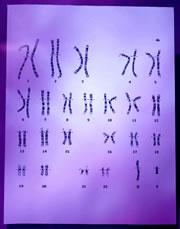Haven't scientists already announced the completion of the human genome?
Well, yes. Twice. In 2000, two teams declared with great fanfare that they had produced a draft copy of the human genetic code, but there were many gaps and errors in this version. Another announcement, in 2003, marked the completion of a far more accurate 'finished' sequence by those involved in the public-financed Human Genome Project, although there are still a few gaps and uncertain areas in this one too.
 Our number one, and biggest, chromosome has now been sequenced.© Getty
Our number one, and biggest, chromosome has now been sequenced.© GettyOver the years, various research groups have also separately published sequences of all 22 numbered chromosomes, plus the X and Y chromosomes. These projects have filled in some of the holes and pinned down the sequences with greater accuracy. Importantly, they also annotated the raw sequences by mapping on to them the position of genes and other important landmarks, making it more useful for other scientists to work with. Chromosome 1 is the final one to be mapped out in this way.
Why is chromosome 1 the last to be finished?
Chromosome 1 is the largest human chromosome, containing about 8% of the entire genome. That's six times longer than its smallest sibling, chromosome 21. Work on this monster started a couple of years after researchers cracked into some of the other chromosomes, says Simon Gregory of Duke University in Durham, North Carolina. Gregory led the project's team of more than 160 collaborators in their eight-year quest.
The task took so long, Gregory says, that it was regularly ridiculed in the annual pantomime at the Wellcome Trust Sanger Institute in Cambridge, UK, where much of the sequencing was done. "There's always friendly rivalry to get your chromosome out first," he says. Now it's finally done, "it's an incredible relief," he adds.
Is there anything notable on chromosome 1?
The chromosome carries an estimated 3,141 genes that manufacture proteins, making it one of the most gene-rich chromosomes. The hope is that this sequence will help scientists to track down the genes underlying the more than 350 diseases linked to chromosome 1. One team, for example, has already used it to find a gene involved in cleft lip and palate.
The scientists identified large chunks and single-letter changes (known as SNPs) that differ between people and might explain an individual's unique characteristics or susceptibility to disease. They also exposed regions of the chromosome that differ between ethnic populations. One gene active in fat tissue, for example, differs in European, African and Asian populations, perhaps because a variant of the gene increased the amount of fatty tissue for populations in cold climes and was favoured by evolution. The results are reported in Nature1.
So how does the human genome begin?
'A' may start the alphabet, but you could argue that 'C' starts the human genome. Scientists conventionally lay out the genome from the top of chromosome 1 to the tip of the Y chromosome, and they discount the repeated patterns of DNA that make up the chromosome tips known as telomeres. Based on all the sequence data now collected, it looks as though our genome started with the chemical building-block cytosine, or C.
What are researchers doing now that they have the full set of sequenced human chromosomes?
ADVERTISEMENT
Around half the genes in the human genome still have no known function, so researchers are trying to figure out what they do, and to reveal more details about how one person's genome differs from another. Scientists are also increasingly scrutinizing the regions outside genes, which were once discounted as junk but are now thought to harbour all kinds of useful sequences.
Is this the end of the Human Genome Project? Or could we see yet another announcement that the sequence is complete?
This is probably the last big landmark for the sequencing effort. "It's closing the last chapter on this volume," Gregory says. "We've wrung as many announcements out of it as we can."
But there is much more yet to learn about the details of our DNA and how it functions: more fanfare on this will surely follow.
Visit our genomecompleted_again.html">newsblog to read and post comments about this story.
Duke University, Durham
